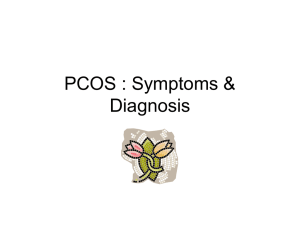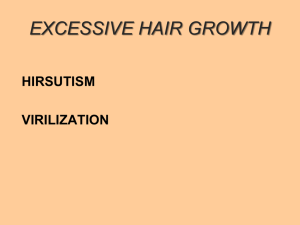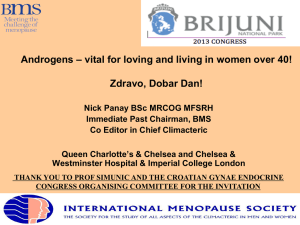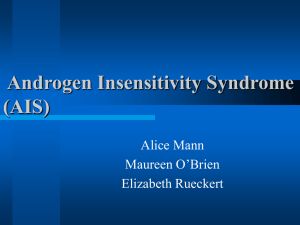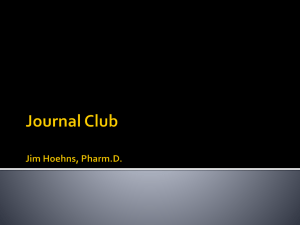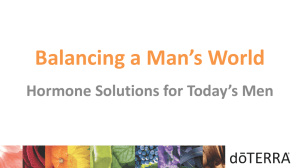Does Androgen Deficiency Exist in Women
advertisement
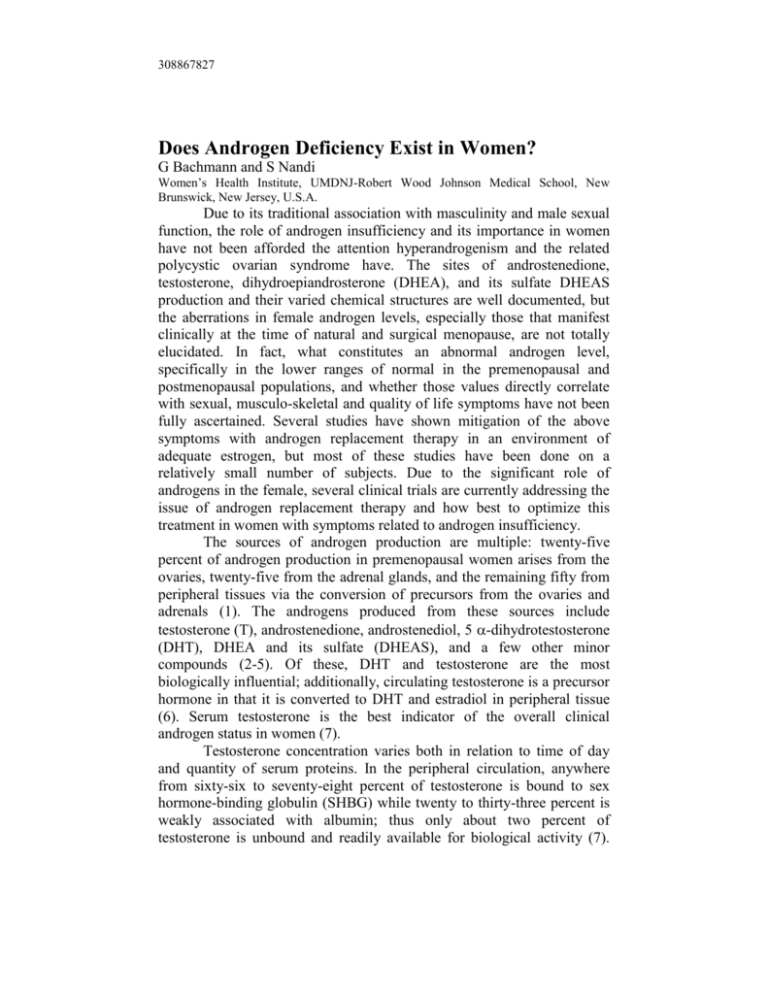
308867827 Does Androgen Deficiency Exist in Women? G Bachmann and S Nandi Women’s Health Institute, UMDNJ-Robert Wood Johnson Medical School, New Brunswick, New Jersey, U.S.A. Due to its traditional association with masculinity and male sexual function, the role of androgen insufficiency and its importance in women have not been afforded the attention hyperandrogenism and the related polycystic ovarian syndrome have. The sites of androstenedione, testosterone, dihydroepiandrosterone (DHEA), and its sulfate DHEAS production and their varied chemical structures are well documented, but the aberrations in female androgen levels, especially those that manifest clinically at the time of natural and surgical menopause, are not totally elucidated. In fact, what constitutes an abnormal androgen level, specifically in the lower ranges of normal in the premenopausal and postmenopausal populations, and whether those values directly correlate with sexual, musculo-skeletal and quality of life symptoms have not been fully ascertained. Several studies have shown mitigation of the above symptoms with androgen replacement therapy in an environment of adequate estrogen, but most of these studies have been done on a relatively small number of subjects. Due to the significant role of androgens in the female, several clinical trials are currently addressing the issue of androgen replacement therapy and how best to optimize this treatment in women with symptoms related to androgen insufficiency. The sources of androgen production are multiple: twenty-five percent of androgen production in premenopausal women arises from the ovaries, twenty-five from the adrenal glands, and the remaining fifty from peripheral tissues via the conversion of precursors from the ovaries and adrenals (1). The androgens produced from these sources include testosterone (T), androstenedione, androstenediol, 5 -dihydrotestosterone (DHT), DHEA and its sulfate (DHEAS), and a few other minor compounds (2-5). Of these, DHT and testosterone are the most biologically influential; additionally, circulating testosterone is a precursor hormone in that it is converted to DHT and estradiol in peripheral tissue (6). Serum testosterone is the best indicator of the overall clinical androgen status in women (7). Testosterone concentration varies both in relation to time of day and quantity of serum proteins. In the peripheral circulation, anywhere from sixty-six to seventy-eight percent of testosterone is bound to sex hormone-binding globulin (SHBG) while twenty to thirty-three percent is weakly associated with albumin; thus only about two percent of testosterone is unbound and readily available for biological activity (7). 308867827 The quantity of active testosterone is further impacted by fluctuations in SHBG levels, which are naturally increased in the presence of estrogens, for example from oral contraceptive pills or estrogen replacement therapy (8). Further, testosterone is secreted in a diurnal pattern with greater production in the morning as compared to later in the day (9). During the reproductive years androgen levels vary according to the menstrual cycle in that androgens and estrogens peak in the middle third of the cycle (10,11). The overall production of androgens is greater in premenopausal women as compared to postmenopausal woman, with healthy reproductive aged women producing about 300 g per day of testosterone (12). The sites of androgen action in the body are multiple. Receptor sites are found in central nervous system pathways, specifically the hypothalamic and limbic systems; peripheral receptors are located in bone, breast, pilosebaceous units, skeletal muscle, and adipose and genital tissue (6). In some of these sites it has been hypothesized that androgens may first need to be converted to estrogens in order to activate the receptor. In many of these systems it is also not clear if a threshold level of androgen is necessary to activate the site and if there is a feedback mechanism to regulate androgen level. Though the ovaries lose their estradiol-producing capacity after menopause, androgen levels do not appear to be immediately affected by the climacteric transition. Average daily testosterone concentrations have been shown to gradually decrease in women between the ages of twenty and fifty. This androgen decline is thought to be due to aging since DHEAS also has a similar descent while the ratio of DHEAS/T stays steady regardless of the time period (13). Androstenedione and testosterone production continues even after menopause, most likely due to unabated stimulation of the ovarian androgen-producing theca cells by elevated concentrations of luteinizing hormone (LH) (7). Despite a greater decrease in androstenedione levels than testosterone postmenopausally, there appears to be no menopause related decrease in these levels as there is with the significant decrease in estrogen levels that is seen with the menopause. (4). In fact, considerable testosterone diminution is documented when women are more than a decade past menopause, with the onset of this decline at approximately age seventy-one years and beyond (4). The reduction in estrogens after menopause results in a concomitant decrease in sex hormone-binding globulin levels, which in turn results in a larger percentage of free unbound testosterone. Only with estrogen replacement therapy and the rise in sex hormone-binding globulin that accompanies treatment is the level of free testosterone diminished. 308867827 Failure to maintain the aforementioned pattern and quantity of bioavailable androgen secretion as a result of surgical menopause or a more rapid reduction in androgen production from either ovarian or adrenal sources results in a state of androgen insufficiency. This ageindependent decrease can be linked for the most part from conditions primarily affecting the ovaries and/or adrenal glands. For example, adenomas, hypophysitis, and other states that lead to pituitary deficiency affect both ovarian and adrenal androgen synthesis (10). Additionally, adrenal production is exclusively targeted in cortisone therapy and ovarian through oral contraceptive pills (10). In the scenario of a bilateral oophorectomy before the onset of natural menopause, serum testosterone and estradiol levels decline by fifty and eighty percent, respectively (14,15). The fifty-percent testosterone reduction holds true for both premenopausal and postmenopausal women after bilateral oophorectomy (15). Obviously, surgical excision of the tissues that provide a quarter of the androgen concentration, even after the cessation of estradiol secretion, places a woman at great risk for symptoms of androgen insufficiency. More importantly, androgen paucity ensues from predicaments where this ovarian function deteriorates in light of intact tissue; some examples are premature ovarian failure, chemotherapy, radiation, and ovarian dysgenesis as in Turner’s syndrome (4,7,10). Finally, as long as physiologic ovarian function is hampered even in the presence of ovulatory ovaries, such as with oral contraceptive pills, lactation, and anorexia nervosa, androgen decline follows (16). With the requisite lack in efficacious quantity, an androgen insufficiency syndrome emerges. A variety of symptoms encompass this state. One of the significant clinical complaints voiced is a decline in sexual function, with decreased sexual motivation, fantasy, frequency, and enjoyment, diminished sexual arousal, and decreased vaginal vasocongestion and lubrication in response to erotic stimuli (4,6,16). In terms of mood, affect and energy, complaints usually include an increased prevalence of depression and headaches, a diminished sense of sense of well-being or dysphoria, and persistent unexplained fatigue (4,6,16). Other symptoms and signs of androgen loss include loss of pubic and axillary hair, increased vasomotor flushing and insomnia at menopause, accelerated loss of bone leading to osteopenia or osteoporosis, decrease in muscle mass, and replacement of muscle with adipose tissue (4,6,16). Since a few of the clinical manifestations of androgen deficiency overlap with those of estrogen deficiency, it has been the standard of clinical practice to replace estrogen deficient women with estrogen replacement therapy and that if menopausal complaints persist after the use of adequate estrogen 308867827 ingestion, then the addition of androgen may be prescribed. There continues to be debate as to whether androgen insufficiency can exist in the reproductive aged female who is regularly ovulating and not on hormonal therapy. (7). Some clinicians treat with the addition of androgen if estrogen replacement alone does not ameliorate menopausal symptoms. Others feel that despite the presence of clinical symptoms in the well-estrogenized patient, there also needs to be a demonstration of low unbound testosterone levels before the diagnosis of androgen insufficiency is made. Unfortunately, most methods available to measure testosterone in women are not reliable and insensitive because they were originally developed to measure the higher concentrations noted in men (10). Women have naturally lower testosterone levels than men so in the scenario of androgen deficiency, the levels are so low that available modalities are unable to ascertain the actual amount and are thus inaccurate (10). Though total T concentration has been checked via total T assay for decades, it fails to account for fluctuations in the free bioactive T fraction that is dependent on SHBG and albumin. Hence, in order to adequately quantify a deficiency, better tests that not only estimate the total T concentration but also calculate the free T and SHBG levels, the more clinically relevant proportions of testosterone, need to be established (6). One such method, the equilibrium dialysis assay, is a free T assay that also is more sensitive to the lower range levels found in androgen deficient female patients (10). Likewise, testosterone levels need analysis when at their apex, during the morning hours and in the middle third of the menstrual cycle, in order to maximize free T concentrations (6). There are beneficial effects in cases where replacement therapy is begun to treat androgen deficiency, as determined by both clinical and quantitative manifestations. In bilateral oophorectomy patients receiving testosterone transdermally, supraphysiologic elevations in T with resultant normal free T concentrations have been shown to improve sexual function and psychological well-being (17). That estrogen replacement therapy alone is usually not sufficient to help sexual dysfunction and quality of life issues has been demonstrated by Sherwin et al. (18,19). Similarly, poorer relief of menopausal symptoms is seen in women solely on estrogen implants than in those with combined estrogen and androgen implants (20,21). HIV infection and its related AIDS wasting syndrome is another condition in which androgen status is known to be low due to undernutrition, generalized illness, and/or more direct effects of HIV disease on the hypothalamic-pituitary-gonadal axis (22). Amongst HIV-infected women, 308867827 androgen deficiency relates to changes in body composition, diminished functional capacity and mental well-being, as well as health perceptions (23). The administration of transdermal testosterone in low (150 g/day) and high (300 g/day) doses causes a gain in weight (24). With physiologic doses of testosterone, this gain tends to be more of fat mass while supraphysiologic doses result in more fat-free mass (24). Also, better social functioning, well-being, general health, and physical function with improved pain tolerance are seen with physiologic testosterone addition (24). Lastly, resumption of spontaneous menses is noted in several previously amenorrheic patients; this may be associated with a gain in weight or fat mass, secondary conversion of testosterone to estrogen, or testosterone’s effect on GnRH pulsatility in HIV-infected women with hypothalamic amenorrhea (24). Thus treatment in known cases of deficiency with androgen relieves some of the physical and emotional symptoms seen in androgen deficiency syndrome. In light of the various functions of androgens in women and the many presenting complaints seen in cases of known deficiency, like bilateral oophorectomy and AIDS wasting syndrome, it is arguable that androgen insufficiency is a clinical entity that deserves the same attention as other endocrinologic deficiency states. The contention is even stronger when replacement of testosterone is shown to ameliorate if not eradicate symptoms even after appropriate estrogenization. In addition to the clinical manifestations, there also needs to be a reliable quantitative measurement of androgens, specifically unbound testosterone concentration and SHBG level, to conclude the presence of such a syndrome. However, current modalities of measurement need refinement - they have to be geared to levels found naturally in women and have to be sensitive in the lower concentrations indicative of deficiency. Moreover, large, randomized, placebo-controlled trials of testosterone administration and the adequate dosages required for a beneficial effect need to be established for a standard methodology to deal with all cases of androgen insufficiency. References 1. Balthazart J. Steroid control and sexual differentiation of brain aromatase. J Steroid Biochem Nat Biol 1997;61:323-39. 2. Demers LM. Biochemistry and laboratory measurement of androgens in women. In: Redmond GP, ed. Androgenic disorders. New York: Raven Press, 1995:21-34. 3. Longcope C. Androgen metabolism and the menopause. Semin Reprod Endocrinol 1998;16:111-5. 308867827 4. Lobo RA. Androgens in postmenopausal women: production, possible role, and replacement options. Obstet Gynecol Surv 2001;56:361-76. 5. Vermeulen A. Plasma androgens in women. J Reprod Med 1998;43:725-33. 6. Bachmann GA, Bancroft J, Braunstein G, et al. Female androgen insufficiency: the Princeton consensus statement on definition, classification, and assessment. Fertil Steril 2002;77:660-65. 7. Braunstein GD. Androgen insufficiency in women: summary of critical issues. Fertil Steril 2002;77:S94-99. 8. Davis SR. Testosterone influences libido and well being in women. Trends Endocrinol Metab 2001;12:33-7. 9. Vermeulen A. The hormonal activity of the postmenopausal ovary. J Clin Endocrinol Metab 1976;42:247-53. 10. Guay AT. Screening for androgen deficiency in women: methodological and interpretive issues. Fertil Steril 2002;77:S8388. 11. Massafra C, De Felice C, Agnusdei DP, et al. Androgens and Osteocalcin during the menstrual cycle. J Clin Endocrinol Metab 1999;84:971-4. 12. Mazer NA. New clinical applications of transdermal testosterone delivery in men and women. J Controlled Release 2000;65:303315. 13. Burger HG, Dudley EC, Cui J, et al. A prospective longitudinal study of serum testosterone, dihydroepiandrosterone sulfate, and sex hormone-binding globulin levels through the menopause transition. J Clin Endocrinol Metab 2000;85:2832-38. 14. Judd HL. Hormonal dynamics associated with the menopause. Clin Obstet Gynecol 1976;19:775-88. 15. Hughes CL Jr, Wall LL, Creasman WT. Reproductive hormone levels in gynecologic oncology patients undergoing surgical castration after spontaneous menopause. Gynecol Oncol 1991;40:42-5. 16. Bachmann GA. The hypoandrogenic woman: pathophysiologic overview. Fertil Steril 2002;77:S72-76. 17. Shifren JL, Braunstein GD, Simon JA, et al. Transdermal testosterone treatment in women with impaired sexual function after oophorectomy. N Engl J Med 2000;343:682-8. 18. Sherwin BB. Changes in sexual behavior as a function of plasma sex steroid levels in post-menopausal women. Maturitas 1985;7:225-33. 308867827 19. Sherwin BB, Gelfant MM. The role of androgen in the maintenance of sexual functioning in oophorectomized women. Psychosom Med 1987;49:397-409. 20. Burger H, Hailes J, Nelson J, et al. Effect of combined implants of oestradiol and testosterone on libido in postmenopausal women. Br Med J (Clin Res Ed) 1987;294:936-7. 21. Burger HG, Hailes J, Menelaus M, et al. The management of persistent menopausal symptoms with oestradiol-testosterone implants: clinical lipid and hormonal results. Maturitas 1984;6:351-8. 22. Grinspoon S, Corcoran C, Miller K, et al. Body composition and endocrine function in women with AIDS wasting. J Clin Endocrinol Metab 1997;82:1332-37. 23. Javanbakht M, Singh AB, Mazer NA, et al. Pharmacokinetics of a novel testosterone matrix transdermal system in healthy, premenopausal women and women infected with the human immunodeficiency virus. J Clin Endocrinol Metab 2000;85:23952401. 24. Miller K, Corcoran C, Armstrong C, et al. Transdermal testosterone administration in women with acquired immunodeficiency syndrome wasting: a pilot study. J Clin Endocrinol Metab 1998;83:2717-25.

